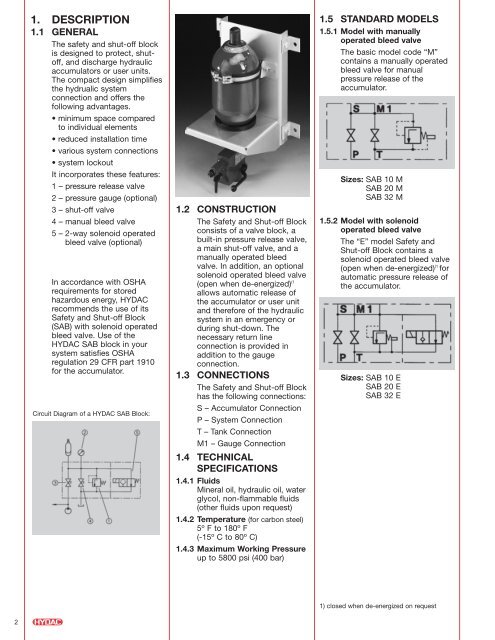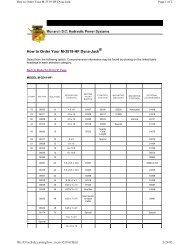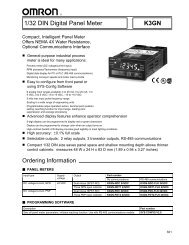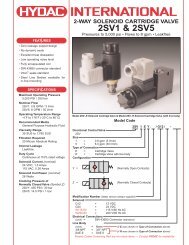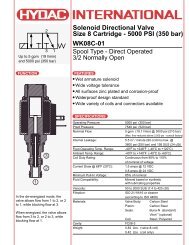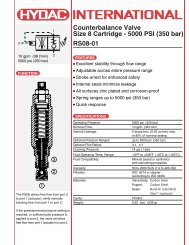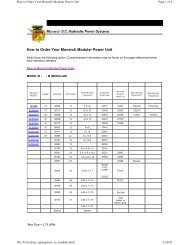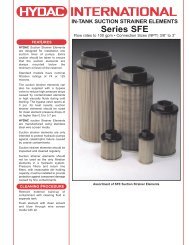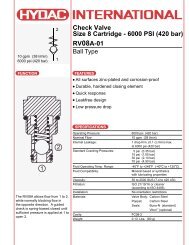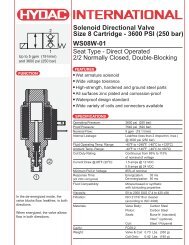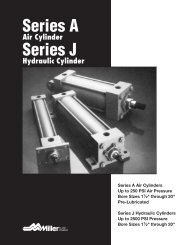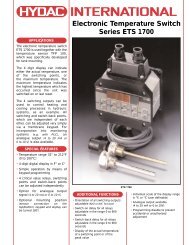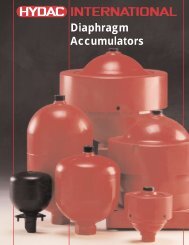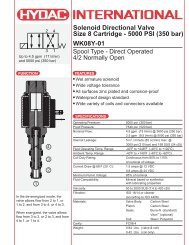Safety & Shut-off Blocks - Airline Hydraulics
Safety & Shut-off Blocks - Airline Hydraulics
Safety & Shut-off Blocks - Airline Hydraulics
You also want an ePaper? Increase the reach of your titles
YUMPU automatically turns print PDFs into web optimized ePapers that Google loves.
1. DESCRIPTION<br />
1.1 GENERAL<br />
The safety and shut-<strong>off</strong> block<br />
is designed to protect, shut<strong>off</strong>,<br />
and discharge hydraulic<br />
accumulators or user units.<br />
The compact design simplifies<br />
the hydrualic system<br />
connection and <strong>off</strong>ers the<br />
following advantages.<br />
• minimum space compared<br />
to individual elements<br />
• reduced installation time<br />
• various system connections<br />
• system lockout<br />
It incorporates these features:<br />
1 – pressure release valve<br />
2 – pressure gauge (optional)<br />
3 – shut-<strong>off</strong> valve<br />
4 – manual bleed valve<br />
5 – 2-way solenoid operated<br />
bleed valve (optional)<br />
In accordance with OSHA<br />
requirements for stored<br />
hazardous energy, HYDAC<br />
recommends the use of its<br />
<strong>Safety</strong> and <strong>Shut</strong>-<strong>off</strong> Block<br />
(SAB) with solenoid operated<br />
bleed valve. Use of the<br />
HYDAC SAB block in your<br />
system satisfies OSHA<br />
regulation 29 CFR part 1910<br />
for the accumulator.<br />
Circuit Diagram of a HYDAC SAB Block:<br />
1.2 CONSTRUCTION<br />
The <strong>Safety</strong> and <strong>Shut</strong>-<strong>off</strong> Block<br />
consists of a valve block, a<br />
built-in pressure release valve,<br />
a main shut-<strong>off</strong> valve, and a<br />
manually operated bleed<br />
valve. In addition, an optional<br />
solenoid operated bleed valve<br />
(open when de-energized) (1<br />
allows automatic release of<br />
the accumulator or user unit<br />
and therefore of the hydraulic<br />
system in an emergency or<br />
during shut-down. The<br />
necessary return line<br />
connection is provided in<br />
addition to the gauge<br />
connection.<br />
1.3 CONNECTIONS<br />
The <strong>Safety</strong> and <strong>Shut</strong>-<strong>off</strong> Block<br />
has the following connections:<br />
S – Accumulator Connection<br />
P – System Connection<br />
T – Tank Connection<br />
M1 – Gauge Connection<br />
1.4 TECHNICAL<br />
SPECIFICATIONS<br />
1.4.1 Fluids<br />
Mineral oil, hydraulic oil, water<br />
glycol, non-flammable fluids<br />
(other fluids upon request)<br />
1.4.2 Temperature (for carbon steel)<br />
5º F to 180º F<br />
(-15º C to 80º C)<br />
1.4.3 Maximum Working Pressure<br />
up to 5800 psi (400 bar)<br />
1.5 STANDARD MODELS<br />
1.5.1 Model with manually<br />
operated bleed valve<br />
The basic model code “M”<br />
contains a manually operated<br />
bleed valve for manual<br />
pressure release of the<br />
accumulator.<br />
Sizes: SAB 10 M<br />
SAB 20 M<br />
SAB 32 M<br />
1.5.2 Model with solenoid<br />
operated bleed valve<br />
The “E” model <strong>Safety</strong> and<br />
<strong>Shut</strong>-<strong>off</strong> Block contains a<br />
solenoid operated bleed valve<br />
(open when de-energized) (1 for<br />
automatic pressure release of<br />
the accumulator.<br />
Sizes: SAB 10 E<br />
SAB 20 E<br />
SAB 32 E<br />
1) closed when de-energized on request<br />
2


